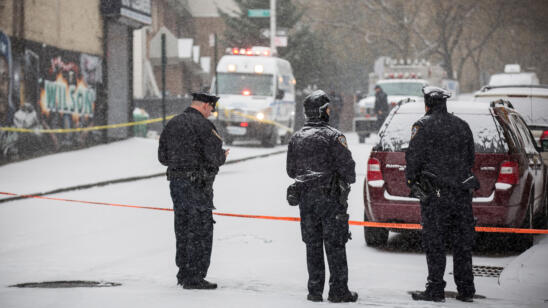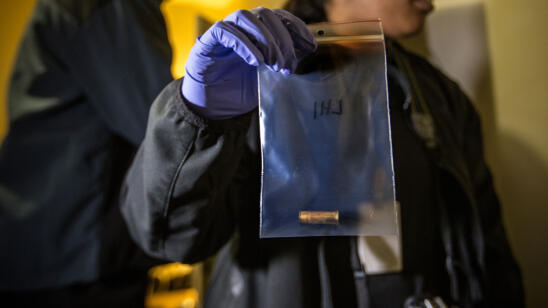Cases can be won or lost because of errors in collecting and protecting evidence. Ken Martin, a 33-year veteran of the Massachusetts State Police, who retired as the commanding officer of the Crime Scene Services Division, has seen his share of crime scenes. A&E True Crime spoke to him about the problems that arise when gathering evidence, and how to avoid having defense attorneys claim contamination.
How easy is it to contaminate a crime scene?
We are always losing hair off our heads or sloughing off DNA—if I shake your hand, I transfer 50 nanograms of DNA. You only need five for a profile. That goes for not only any kind of bodily excretion or secretion, but you could also be leaving impression evidence–latent fingerprints, footprints or footwear impressions, which are very important.
When a crime scene occurs, the first thing we teach new recruits or officers is that there are three rules. They are: Touch nothing, touch nothing and touch nothing. According to Locard’s Principle, when you touch something you could leave prints, DNA or hair/fibers. Some people are more prone to DNA deposition than others. In a crime lab, I heard that one of the examiners, on more than one occasion, contaminated the evidence with his own DNA. This thereby called into question the whole processing of this entire case. Ultimately, all the DNA evidence was thrown out in that case because of that.
What other ways have you seen crime scenes altered?
When I get to the crime scene I need [it] in pristine or as close to perfect condition as [the investigator] found it. Not only does it lead to potential physical evidence (one of the things I do is bloodstain analysis and crime-scene reconstruction), but the fact that a certain piece of evidence, such as blood splatter on the floor, is in a particular place may lend itself to telling what happened.
I had a case where a purse was placed on a bed where a female victim had been beaten and fatally stabbed. When I get to the scene, here’s this purse placed on top of the bedclothes. I look at the purse and there’s a lack of spatter on the purse, but there is spatter under it. That means that someone put it there after the fact. So, I will question the first responders. They may say ‘I didn’t do it! I didn’t do it.’ But I pointed out that either the suspect did it or one of the officers [did], and that I don’t have a problem with it, I just need to know. One of them said, ‘You know, I was looking for an ID, so I remember I looked in the purse.’
How crucial is it to speedily process the crime scene evidence?
There was a case where an elderly woman was murdered in a park. They called me to go out there. I said, ‘Stay away from her.’ There was no problem with public contamination of the scene because it was somewhat isolated. Knowing that no one had been out there, we were able to get a tracking dog out there. Because it was obvious, in my opinion, that the victim had been sexually assaulted, I took a sample carefully of the leaves from between and around the victim’s lower torso and legs. We took it back and let the dog sniff it for scent. The dog took off through the woods and began to track.
Another scenario: With serial killers, you might find a body in the woods. If it’s at night, it’s my opinion that it’s better to leave it until the next day. Because, no matter how much lighting you bring out there, it’s not enough. You might stir up the ground, which may obstruct or hide pieces of evidence. So you set up a perimeter and leave an officer to guard it. You can go back at first light and process the scene.
How does weather impact the degradation of evidence?
I had a case where there was a snowstorm coming in. My position was that we needed to get the body out ASAP before it snows, [when there is] bare ground and we can see what we’re dealing with.
[With hot weather] you could have insect infestation. It usually takes 48 hours for eggs to hatch and fly larvae to form. You could [also] get some discoloration, some marbleizing of tissue. Remember: No matter what, you’re going to take photos first thing, so, at least go in and capture all your photos. In some cases, the medical examiners don’t come out to the scene, so they like to see photos of the bodies for time-of-death indication.
What’s the first thing you do when you get to a crime scene?
You get a sign-in list of everyone who has gone into the inner perimeter of a crime scene. One reason why: When we go back and start to develop footwear impressions, we have taken photos of the outsoles of the shoes of the first responders, which we use when or if we begin to develop latent footwear prints. We also ask them to write what they are doing in the inner perimeter; this is because we may need to go back to them and ask for a DNA sample to do our eliminations.
As a bloodstain analyst, have you had experience where blood spatter was compromised and you couldn’t use it?
Say we have spatter on a wall—that type of evidence usually stays intact. It’s pretty hard to compromise spatter on a wall. In court, there will be an examination of the expert as to degree of expertise. (You see this all the time; there are experts on both sides. Sometimes they have competing hypotheses.) As far as bloodstain analysis, in one case it could be very important, but not in another case.
Scenario one: Someone is beaten in the corner of a room. They are beaten about the head area, so there are multiple lacerations, contusions and fractures. You anticipate that the spatter radiates out from the source. I use a corner as an example because you see there are six different mechanisms that create patterns. One is impact. I’d see spatter on at least two walls, in this case. I look at ellipses or the ‘area of origin’ where it happened. And as a person bleeds out over the evening, there is a large pool of blood.
Scenario two: You’re in a large gym. A person is in the middle of the floor and the same thing happens. (They are beaten about the head area.) Some of the spatter is going to go out quite a distance because you don’t have those vertical walls close by. And the victim is slowly bleeding out, because gravity takes over after death and the body continues to lose blood. Much of the spatter on ground will be covered over by pooling and an accumulation of blood. Would it preclude me from coming up with the conclusion that the person was beaten? [Spatter] is still going to be left behind.
Related Features:
What’s It Really Like at a Forensic Body Farm?
Challenges and Surprises of Crime Scene Investigating
How Accurate Are Crime Scenes on TV? A Retired CSI Detective Tells All


